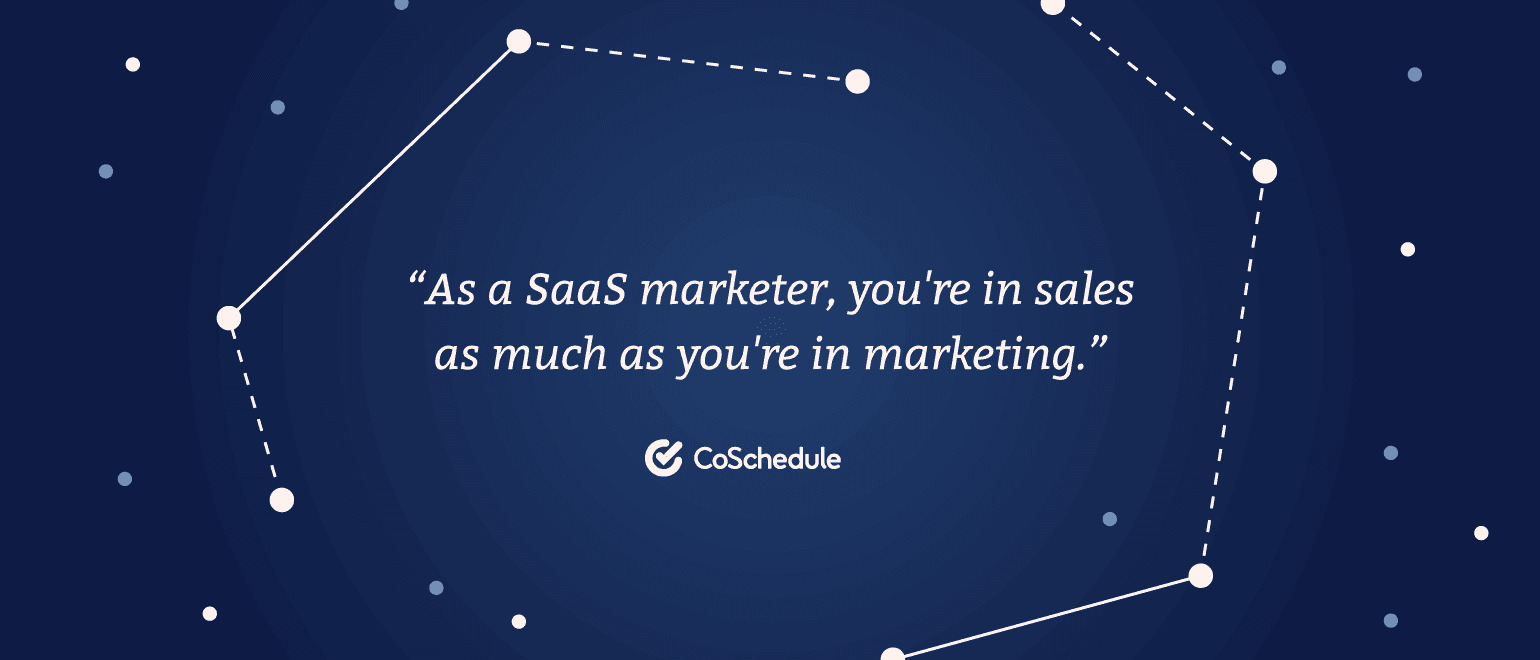A Simple SaaS Marketing Strategy For Amazing Results (+ 14 Templates)
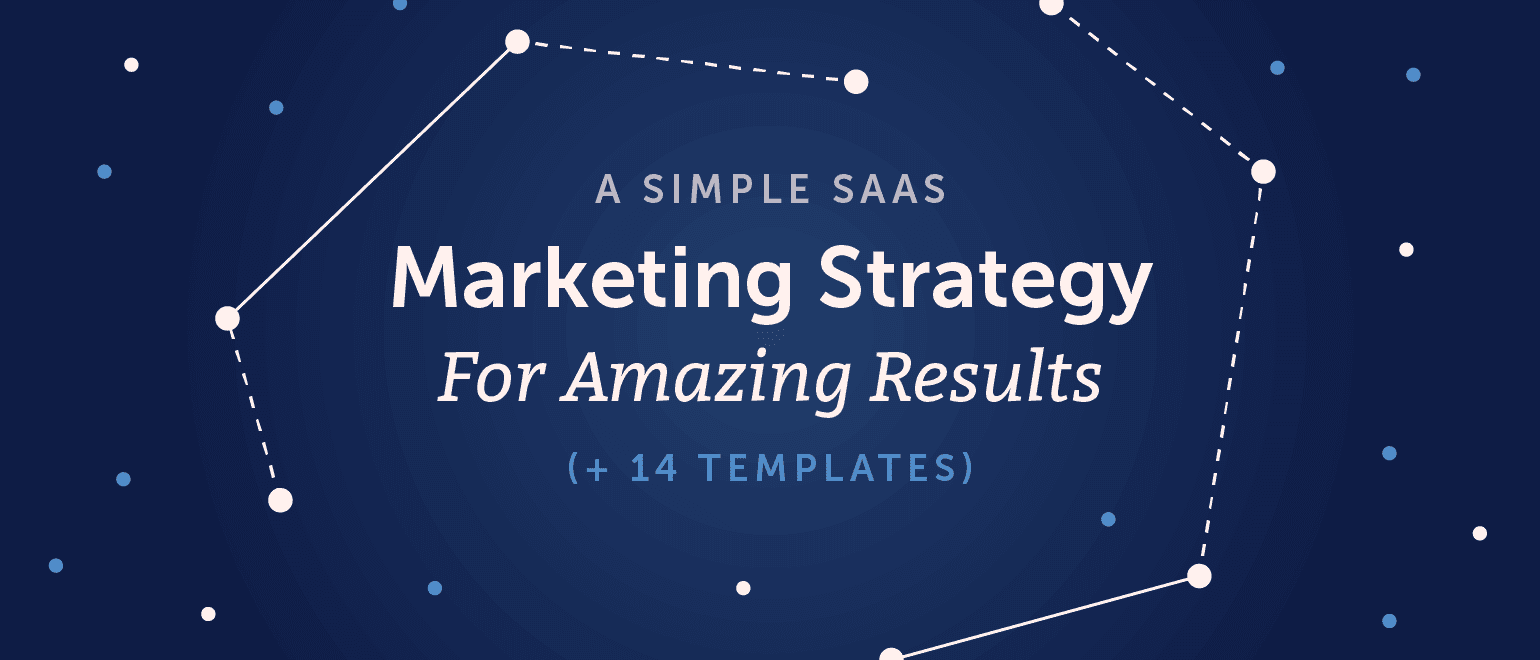 Marketing strategy looks different for everyone.
... In-house marketing teams often do it all — from social media marketing to brand positioning.
... Agencies handle marketing for clients in diverse verticals.
... And today, there's a fresh breed of marketer in a field with unique challenges of their own: SaaS marketing.
So, if you're in SaaS marketing, you're absolutely in the right place. Because in this post, you're going to get everything you need to start a proven SaaS marketing strategy.
I'll share with you a 3-stage SaaS marketing strategy:
Marketing strategy looks different for everyone.
... In-house marketing teams often do it all — from social media marketing to brand positioning.
... Agencies handle marketing for clients in diverse verticals.
... And today, there's a fresh breed of marketer in a field with unique challenges of their own: SaaS marketing.
So, if you're in SaaS marketing, you're absolutely in the right place. Because in this post, you're going to get everything you need to start a proven SaaS marketing strategy.
I'll share with you a 3-stage SaaS marketing strategy:
- Web traffic: how to get it and why it's your lifeblood.
- Email marketing: how email can be an engine for massive growth.
- Leads: how to nurture your audience into leads for your sales team.
- A 3-resource SEO Copywriting Template Bundle for generating maximum web traffic.
- A 9-resource Email Marketing Template Bundle for growing a profitable list.
- A Call-To-Action guide for converting more trial signups and leads.
- A Marketing Research Process guide to get (and keep) new customers.

A Simple SaaS Marketing Strategy For Amazing Results (+ 14 Templates)
Click To TweetWhat Is SaaS Marketing?
So, what is SaaS marketing?SaaS marketing is the process of promoting and selling a software product with license, or recurring revenue, cashflow.
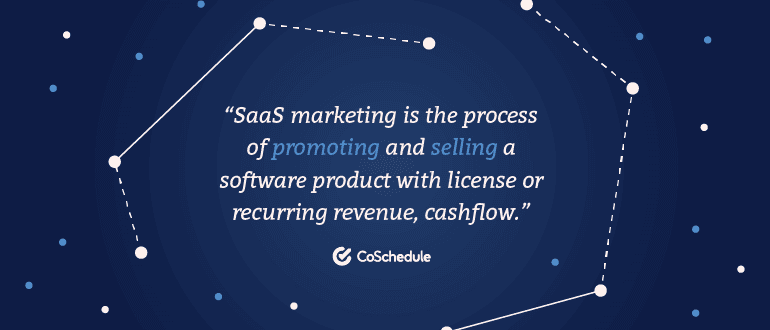 SaaS is an acronym that means "Software as a Service." And it refers to a company builds and sells software available to anyone with an internet connection.
The first SaaS company actually started back in the '90s by selling floppy discs. After hitting hard times, they pivoted and began selling software online (and eventually sold for billions).
Today, SaaS marketing (and companies) are mainstream — and nearly synonymous with what it means to be a startup. For more context, here are some examples of SaaS companies:
SaaS is an acronym that means "Software as a Service." And it refers to a company builds and sells software available to anyone with an internet connection.
The first SaaS company actually started back in the '90s by selling floppy discs. After hitting hard times, they pivoted and began selling software online (and eventually sold for billions).
Today, SaaS marketing (and companies) are mainstream — and nearly synonymous with what it means to be a startup. For more context, here are some examples of SaaS companies:
- Salesforce: The most popular customer relationship management (CRM) platform on the planet.
- Intercom: A customer engagement platform for sales, marketing, and support.
- Autopilot: An intuitive marketing automation platform.
- Slack: The communication hub for teams and communication.
- CoSchedule: The world's best-selling marketing calendar and marketing management platform. (That's right, we're a SaaS company too!)
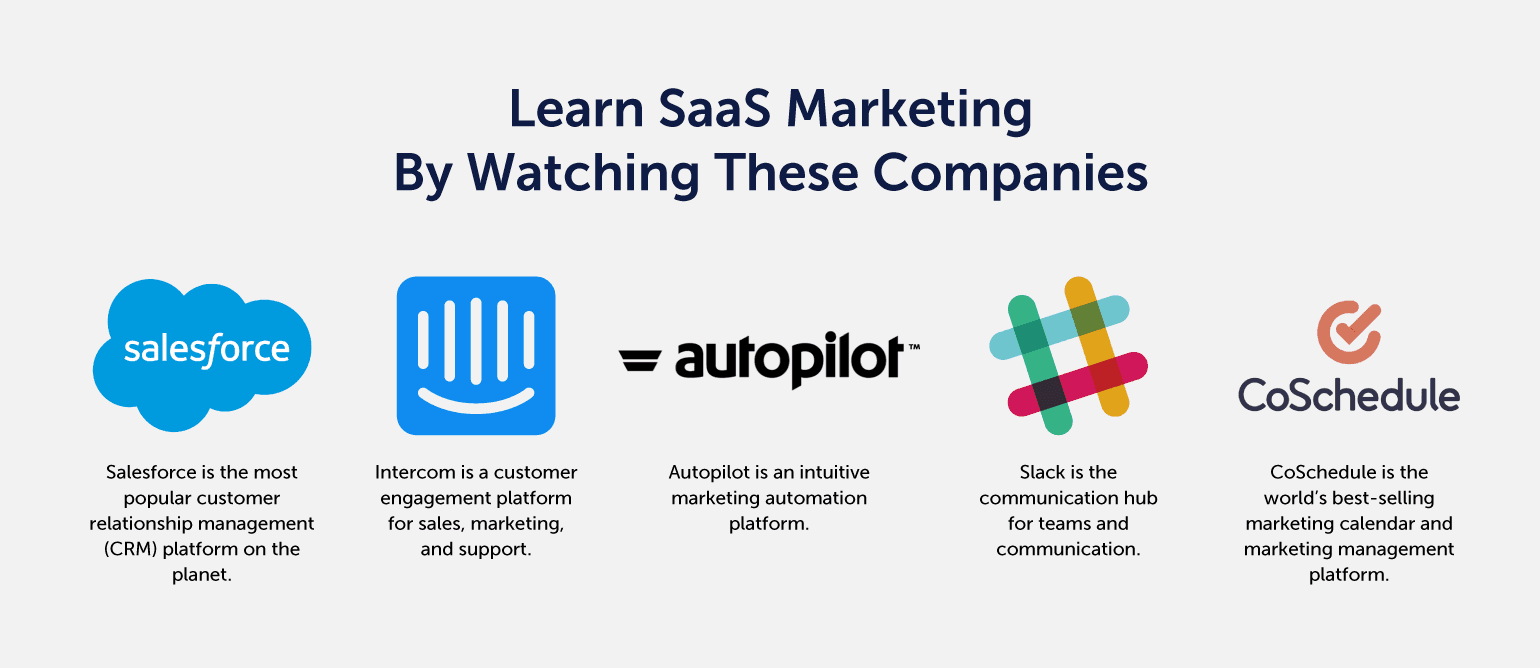
What is SaaS marketing all about? Get the complete guide (and 14 free templates) here:
Click To TweetWhere Your SaaS Marketing Strategy Starts
While many of the same marketing principles apply, there are unique goals and key performance indicators (KPIs) you should be after as a SaaS marketer. Because your goals determine your actions, they are the North Star for your entire strategy. To start, there are three big metrics every SaaS marketer should work to influence:- Web traffic
- Email subscribers
- Qualified leads
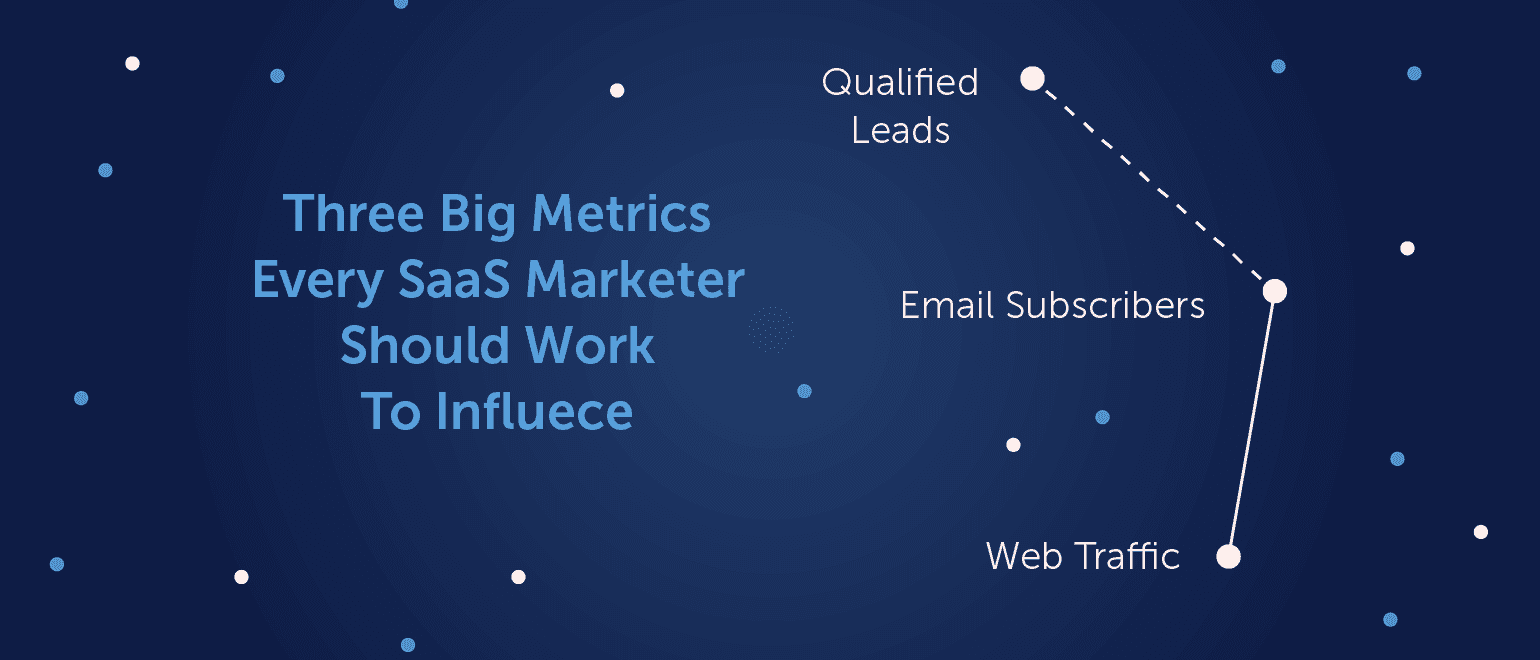 You might be thinking, "But what about customers?! What about trial signups?! What about a fully-stocked snack bar to power my brains?!"
You might be thinking, "But what about customers?! What about trial signups?! What about a fully-stocked snack bar to power my brains?!"
 Great questions.
The great news is, customers, trials, and awesome perks (for being successful) will come when you master these three metrics.
In fact, CoSchedule's rapid growth as a SaaS startup is a testament to that. We followed exactly this path. In fact, our CEO outlined our entire growth strategy in his book, 10x Marketing Formula.
Great questions.
The great news is, customers, trials, and awesome perks (for being successful) will come when you master these three metrics.
In fact, CoSchedule's rapid growth as a SaaS startup is a testament to that. We followed exactly this path. In fact, our CEO outlined our entire growth strategy in his book, 10x Marketing Formula.
Why These SaaS Marketing Metrics Work
So, why do these three metrics work? Because, when pursued together, they become a complete SaaS marketing funnel that will generate results long-term.Marketing funnels (also known as purchase or sales funnels) illustrate the phases of the buying cycle from unawareness of a product all the way through to making an actual purchase.
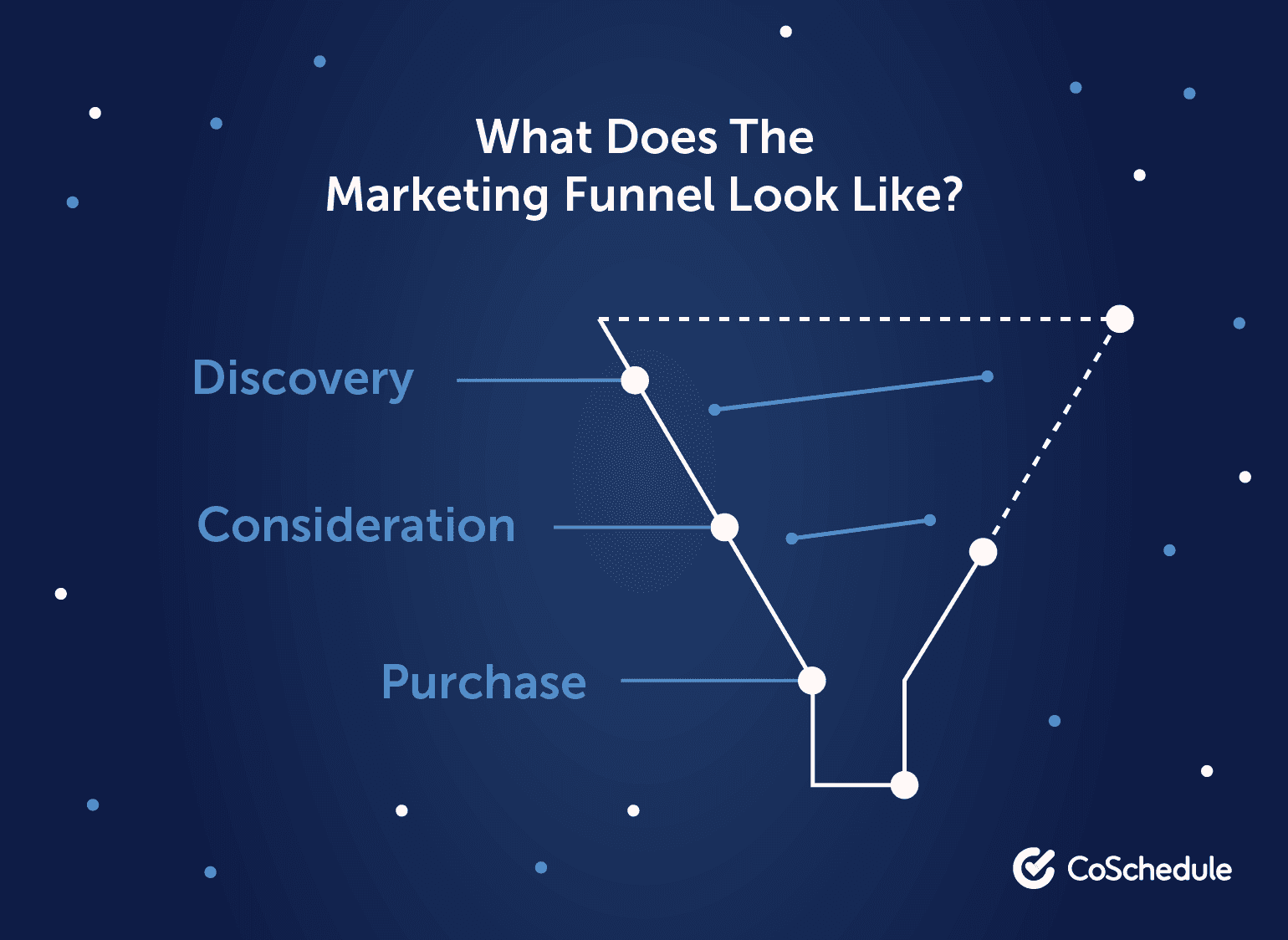
- Discovery: web traffic fuels the continual discovery of your brand.
- Consideration: email marketing helps nurture your traffic into qualified leads.
- Purchase: leads are converted into trial sign ups and customers via sales or self-serve processes.
Focus Your One Metric That Matters
Step one in your SaaS marketing journey is to use a principle called One Metric That Matters (1MTM). It's a simple way to prioritize and execute against your most important metric.Focus On Your 1MTM
First, your team will focus completely on increasing your 1MTM. This frees you from getting swarmed by the constant barrage of popcorn metrics. Instead of chasing ten things at once, you'll work on the highest priority at a time. This will keep your eyes locked on a singular point, the one part of the business we have decided to value more highly than any other.Discipline To Grow Your 1MTM
Second, this kind of focus creates discipline. The power here is that focusing everything on your 1MTM makes your team totally accountable to increasing it. Think about it like this.... Imagine you're a marketing manager overwhelmed by trying to grow your company’s social following, website traffic, email list, and leads. You'd be swimming metrics, dashboards, spreadsheets, and competing priorities. ^^^ And this might sound familiar, already... However, where the 1MTM shines is if you were to look at all of those data, you'd learn you can grow all of those metrics as long as you drive tons of quality web traffic. So, as you increase traffic, the rest of the metrics downstream take care of themselves.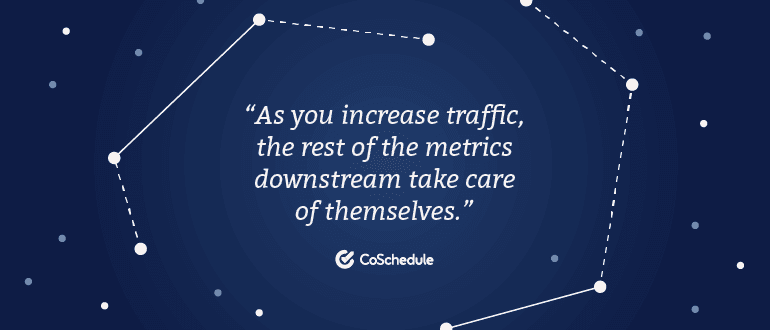 So, let's jump into your first 1MTM, getting web traffic.
So, let's jump into your first 1MTM, getting web traffic.
Here's how to get your SaaS business to your first 1MTM
Click To TweetSaaS Marketing: Grow Relevant Web Traffic
Web traffic is where your SaaS marketing funnel will (nearly) always begin. Our company has grown on the wings of content marketing. And nearly 100 percent of our customers have started as curious visitor on our site. So, your first goal is to grow your relevant web traffic over time. We launched our website about five years ago. And as you can see, we started where everyone else does: with no traffic, no leads, and no customers. The cool part is how we've grown our traffic from nothing to around 1,500,000 pageviews per month...
...largely for free!
Which is great news if you're a bootstrapped startup, like we are.
We've grown our web traffic by investing heavily in:
The cool part is how we've grown our traffic from nothing to around 1,500,000 pageviews per month...
...largely for free!
Which is great news if you're a bootstrapped startup, like we are.
We've grown our web traffic by investing heavily in:
- Content marketing,
- Search engine optimization (SEO),
- And giving away awesome marketing tools.
Content Marketing
Here's the deal. Content marketing isn't new. It's wide-scale adoption is decades old by now. But the truth is that content marketing is still viable — and will continue to be so into the indefinite future. The Content Marketing Institute defines content marketing this way:Content marketing is a strategic marketing approach focused on creating and distributing valuable, relevant, and consistent content to attract and retain a clearly defined audience — and, ultimately, to drive profitable customer action.Content marketing can be anything from... ✍️ blogging... ? to publishing whitepapers... ? to hosting a podcast... ? to video marketing. No matter what content you're creating, the key point is to "drive profitable customer action." We SaaS marketers aren't in the business of being clever with our content. We're in the business of turning visitors into customers! The best way to do this is by creating content that fits into your "content core."
Your content core connects the dots between the value your business provides and what your audience cares about.
 This single principle helps you drive relevant web traffic better than anything else I've ever experienced.
It drives the bus for every topic you choose to create content around.
This single principle helps you drive relevant web traffic better than anything else I've ever experienced.
It drives the bus for every topic you choose to create content around.
 For example, let's say your SaaS company created an app that helps people with personal budgeting. And because your 1MTM is growing web traffic, you've chosen to invest in blogging as your primary form of content marketing.
To choose content core topics, answer two questions:
For example, let's say your SaaS company created an app that helps people with personal budgeting. And because your 1MTM is growing web traffic, you've chosen to invest in blogging as your primary form of content marketing.
To choose content core topics, answer two questions:
- What major value does our software add to our customers?
- What related problems does our audience care about solving?
Drive Massive Traffic With SEO
Now, if the content core tells you what to talk about... The next two traffic levers tells you how to get people to see it... SEO is a tried-and-true method of gaining consistent traffic. Search Engine Land defines it like this:SEO stands for “search engine optimization.” It is the process of getting traffic from the “free,” “organic,” “editorial” or “natural” search results on search engines.The gist of SEO is to make your content readable (and findable) by both people and robots. And while it's an extremely deep topic, and a discipline all its own, effective SaaS marketing depends on it. There are phenomenal guides available, like this one from Ahrefs, but if you grabbed your bundle, you'll find three awesome resources to get you started.
SEO Content Strategy
 First, you'll find the quick SEO overview guide called the SEO Content Strategy Template.
It walks you through a strategy for content optimization...
...all with the goal of turning you into an SEO rockstar ?
It walks you through quick tips to get started + includes a walkthrough to nail your strategy. It includes:
First, you'll find the quick SEO overview guide called the SEO Content Strategy Template.
It walks you through a strategy for content optimization...
...all with the goal of turning you into an SEO rockstar ?
It walks you through quick tips to get started + includes a walkthrough to nail your strategy. It includes:
- The basics of an SEO content strategy.
- How to define your brand's SEO content strategy.
- Research methods for targeting topics and keywords.
- A roadmap for executing your strategy.
- A guide to creating optimized content.
On-Page SEO Checklist
 Next, you'll find the On-Page SEO Checklist.
According to Moz:
Next, you'll find the On-Page SEO Checklist.
According to Moz:
On-page SEO is the practice of optimizing individual web pages in order to rank higher and earn more relevant traffic in search engines.This checklist contains 19 key questions to ask about your most important pages:
- Has keyword research been completed?
- Do you understand the search intent behind your chosen keyword?
- Is the primary keyword present in the title tag, H1, body content, and an image file name?
- Is the title tag less than 70 characters long?
- Is the meta description 150 characters or less?
- Are headers structured logically, with just one H1 tag followed by appropriate H2, H3, H4 (etc.) tags?
- Are variations of the primary keyword included in the body content and H2/H3 header tags?
- Are images properly optimized (keyword in file name, appropriate alt-tag, small file size, high quality?)
- Are internal links present to other pages on your site?
- Are external links present to other reputable websites?
- Are no-follow tags applied to affiliate links (if present)?
- Are synonyms of the primary keyword included in the post copy?
- Do all links use appropriate anchor text (meaning, is the highlighted linked text relevant to the page being to)?
- Is the content sufficiently unique (re: non-duplicative of other content on your site)? Have appropriate blog
- Have categories and tags been selected?
- Are your analytics and tracking tools correctly configured?
- Is my site mobile-friendly?
- Are all images uploaded at the exact size I want them to appear on my site?
- If this is a blog post, have I added at least one (and no more than two) relevant categories?
SaaS Marketing: Your Email List
Now, it's time the second stage of SaaS marketing: email marketing. Though it's occasionally pronounced dead, email marketing is very much alive. And for SaaS marketing, in particular. At CoSchedule, we've seen a nearly 300 percent return on our investment in email marketing. We believe it's one of the most valuable assets we have. As of writing this, our email list is nearing 500,000 subscribers! But this didn't happen on its own.Why Build An Email List?
Online chat with either people or bots is an incredible innovation in SaaS marketing. For instance, according to research by Salesforce, 69 percent of consumers prefer chatbots for quick online communication. However, even in a world of chatbots, email still has its place. It is an "owned" connection to your audience, rather than a "rented" connection. An email list is an owned, direct, and permission-based line of communication. When you send an email, it gets delivered (deliverability issues aside). However, something like a social media audience is a rented connection. Your organic reach is controlled by the network — and everyone knows reach is in rapid decline. Right now, it sits somewhere below 2 percent, on average. This means brands who rely mostly on social media face an uphill battle if they don't pay for increasingly higher media buys.
Compare this to the fact that 38 percent of average North Americans check their inboxes 4 – 15 times per day...
...and you have some compelling numbers in favor of a strong email list.
So, let's talk about how to grow and connect with your email list.
This means brands who rely mostly on social media face an uphill battle if they don't pay for increasingly higher media buys.
Compare this to the fact that 38 percent of average North Americans check their inboxes 4 – 15 times per day...
...and you have some compelling numbers in favor of a strong email list.
So, let's talk about how to grow and connect with your email list.
Grow Your Email List With Content Upgrades
First, use content upgrades as a method for growth. They are companion resources to content like blog posts, articles, or reports. And if you're reading this, you've probably seen hundreds — if not thousands — of them. In fact, we've used one in this very post ? Using them to build your list is easy. Simply gate them behind an email signup form. Then your audience will get the resource by "paying" with an email address. What does a content upgrade look like? Well... Whatever your audience will find valuable! At CoSchedule, we routinely use: ? PDF guides, ? Worksheet templates, ✅ Checklists, ? Spreadsheets for tracking and planning, ? Custom Google Analytics reports, ? Exclusive audio interviews, ? Access to educational video content, ? Photoshop CC actions, ? Slide decks, ? And everything else our audience needs to put our advice into practice. We have a resource library packed around 300 content upgrades. And in total, they account for more than 250,000 of our email signups.
To summarize, valuable content upgrades can be one of the most vital list-building engines you have. And they are an excellent way to add more value to all of that traffic you're working so hard to drive!
Simply put, if you're doing content marketing, they're too important to skip.
We have a resource library packed around 300 content upgrades. And in total, they account for more than 250,000 of our email signups.
To summarize, valuable content upgrades can be one of the most vital list-building engines you have. And they are an excellent way to add more value to all of that traffic you're working so hard to drive!
Simply put, if you're doing content marketing, they're too important to skip.
Grow Your Email List By Giving Away Free Tools
In line with content upgrades, giving your access to free tools in exchange for an email address adds rocket fuel to growth. You've probably used your fair share. For example:- Moz's Keyword Explorer tool gives you access to part of their software for keyword research.
- Hubspot's Website Grader analyzes your site's performance and gives you actionable tips to improve it.
- Neil Patel's SEO Audit shows actionable tips for improving your site's visibility online.
Headline Analyzer Studio
Writing great headlines is key to getting clicks on your content. So, as content marketers, we take our headlines seriously. Our process has always been to write 25 headlines for every post. This discipline makes you work through the cruft and get to the gold. However, we soon realized that our software actually had north of 1,000,000 headlines — complete with social share data — from thousands of users. Being the nerds that we are, we did intensive research to find the highest performing headlines. Then we crafted formulas that our team started using. But... This is where it got interesting... We created a free tool called Headline Analyzer Studio, fueled by the same data. And we gave it away for free. It generates a quality score for users and even provides suggestions to optimize it. This tool gets around 80,000 pageviews each month. And to date, has netted around 75,000 email signups.
Notice how the 1MTM of web traffic and email signups play nicely together?
That's exactly the power of giving away a free tool that solves real problems for your audience.
And to date, has netted around 75,000 email signups.
Notice how the 1MTM of web traffic and email signups play nicely together?
That's exactly the power of giving away a free tool that solves real problems for your audience.
 Even cooler is this tool has become baked right into our product!
So, every time someone uses our Headline Analyzer Studio, they're experiencing just a sliver of CoSchedule's value.
We've done the same thing with our free tools the Social Message Optimizer...
Even cooler is this tool has become baked right into our product!
So, every time someone uses our Headline Analyzer Studio, they're experiencing just a sliver of CoSchedule's value.
We've done the same thing with our free tools the Social Message Optimizer...
 ...and the Email Subject Line Tester.
...and the Email Subject Line Tester.
 Each tool drives similar results to the Headline Analyzer Studio.
Plus, they again highlight the power of our tool.
CoSchedule integrates with every major social media network. When someone uses our Social Message Optimizer, they're seeing a snapshot of how CoSchedule can amplify their social media effectiveness.
The same goes for our Email Subject Line Tester. Because we also integrate with email platforms like Mailchimp, Constant Contact, Active Campaign, Campaign Monitor, Hubspot, and more...
Building your email list is paramount for SaaS marketing success. And sets you up for the third 1MTM in this simple strategy: generating qualified leads.
Each tool drives similar results to the Headline Analyzer Studio.
Plus, they again highlight the power of our tool.
CoSchedule integrates with every major social media network. When someone uses our Social Message Optimizer, they're seeing a snapshot of how CoSchedule can amplify their social media effectiveness.
The same goes for our Email Subject Line Tester. Because we also integrate with email platforms like Mailchimp, Constant Contact, Active Campaign, Campaign Monitor, Hubspot, and more...
Building your email list is paramount for SaaS marketing success. And sets you up for the third 1MTM in this simple strategy: generating qualified leads.
SaaS Marketing: Generating Qualified Leads
Qualified leads are an important evolution in your SaaS marketing journey. This is also the stage where things can get far more complex. Often you're dealing with CRMs, marketing automation, lead scoring, and multiple layers of sales reps. Regardless of how simple or complex your org chart and tech stack is, though, the simplest place to start is by focusing on conversions. And that means writing phenomenal calls-to-action (CTAs).The 5 Stages Of Awareness
To write powerful CTAs, you need to discern exactly where your audience is in relation to making a purchase. One of my favorite marketers is Joanna Wiebe, and she's a treasure trove of knowledge when it comes to exactly this. In a recent interview, she describes the "Five Stages of Awareness" every person moves through on their way to purchase. The five stages are:- Unaware
- Pain aware
- Solution aware
- Product aware
- Most aware
 Let's walk through them step-by-step.
First, each person is unaware.
Which means they may not be able to fully articulate their problem or pain — and especially not your role as a solution. This stage requires top-of-the-funnel content to move them to the next stage of awareness.
Second, your audience starts feeling and understanding their pain.
Here, they're feeling a specific pain, but they may not understand what solutions exist.
For example, imagine they're a marketing manager who's totally overwhelmed. Their team is missing deadlines. They're stuck in constant fire drills. And are battling constant stress around being a good leader.
At this point, they won’t know how to solve this pain. They're simply aware that it exists and looking for a fix.
Third, they've learned there’s a cure for the pain.
They're pain aware when they know there's a way out... But they haven't yet matched the pain to a specific solution.
Fourth, they've learned knows you can solve their pain.
Now they are product aware, which means they know that your product is one of the solutions to their pain.
They're actively searching...
They're combing through reviews on G2 Crowd...
They're checking out Product Hunt...
And (hopefully) they're finding all of your wonderful content core topics because of your SEO mastery!
In short, this is where you're going head-to-head with your competition.
Fifth, they know you're the best solution to their pain.
They've arrived at the wonderful stage called most aware!
They believe you're the best solution for their pain, and they're ready to try or buy.
They're ready for a trial, a sales call, or even a purchase.
And this is where you have your qualified leads ?
Let's walk through them step-by-step.
First, each person is unaware.
Which means they may not be able to fully articulate their problem or pain — and especially not your role as a solution. This stage requires top-of-the-funnel content to move them to the next stage of awareness.
Second, your audience starts feeling and understanding their pain.
Here, they're feeling a specific pain, but they may not understand what solutions exist.
For example, imagine they're a marketing manager who's totally overwhelmed. Their team is missing deadlines. They're stuck in constant fire drills. And are battling constant stress around being a good leader.
At this point, they won’t know how to solve this pain. They're simply aware that it exists and looking for a fix.
Third, they've learned there’s a cure for the pain.
They're pain aware when they know there's a way out... But they haven't yet matched the pain to a specific solution.
Fourth, they've learned knows you can solve their pain.
Now they are product aware, which means they know that your product is one of the solutions to their pain.
They're actively searching...
They're combing through reviews on G2 Crowd...
They're checking out Product Hunt...
And (hopefully) they're finding all of your wonderful content core topics because of your SEO mastery!
In short, this is where you're going head-to-head with your competition.
Fifth, they know you're the best solution to their pain.
They've arrived at the wonderful stage called most aware!
They believe you're the best solution for their pain, and they're ready to try or buy.
They're ready for a trial, a sales call, or even a purchase.
And this is where you have your qualified leads ?
Write Compelling CTAs For Trial Signups
In SaaS marketing, free trials are the norm — and a perfect next step. But what's vital is that you set the table for success. The five stages of awareness help you bridge education gaps. And also deeply connect your audience's pain with your solution. While hundreds of different copywriting techniques exist, the simple truth is this...As a SaaS marketer, you're in sales as much as you're in marketing.So, don't get lost in the forest of marketing techniques or the psychology of persuasion. Make sure you actually sell with your content and strong calls to action.
No Selling, No Qualified Leads
If you don't sell, you won't generate qualified leads. Be clear. Be concise. Be bold. Don't assume your audience will take profitable action without being invited to do so. In my experience, one of the biggest hurdles marketers have is a fear of being "too salesy." But I think there's a better way of thinking about it. If you have paying customers, it means you're helpful. It means your product adds value to them. So really, as marketers, the most helpful thing we can do for our audience is to make them customers.As marketers, the most helpful thing we can do for our audience is to make them customers.
Click To TweetBring It All Together
SaaS marketing is highly competitive. It's predicted that by 2020, there will be more than 75,000 SaaS companies globally. Fortunately, you've got the SaaS marketing framework to rise to the top. To hit that Inc. 5000 list. To get your hockey stick growth on. Want to know one last secret? If you want to get there faster as a marketer... Then CoSchedule is your rocket ship. With CoSchedule, you'll get everything in one place. Your team will be in sync without endless meetings. All project communication is organized in beautiful threads rather than messy email chains. And you have one calendar to rule them all... ...to get a bird's-eye-view of all your marketing. Best, you can learn exactly what marketing problems CoSchedule can solve for you and your team in just 30 minutes (or less), by picking a time for a marketing demo of CoSchedule!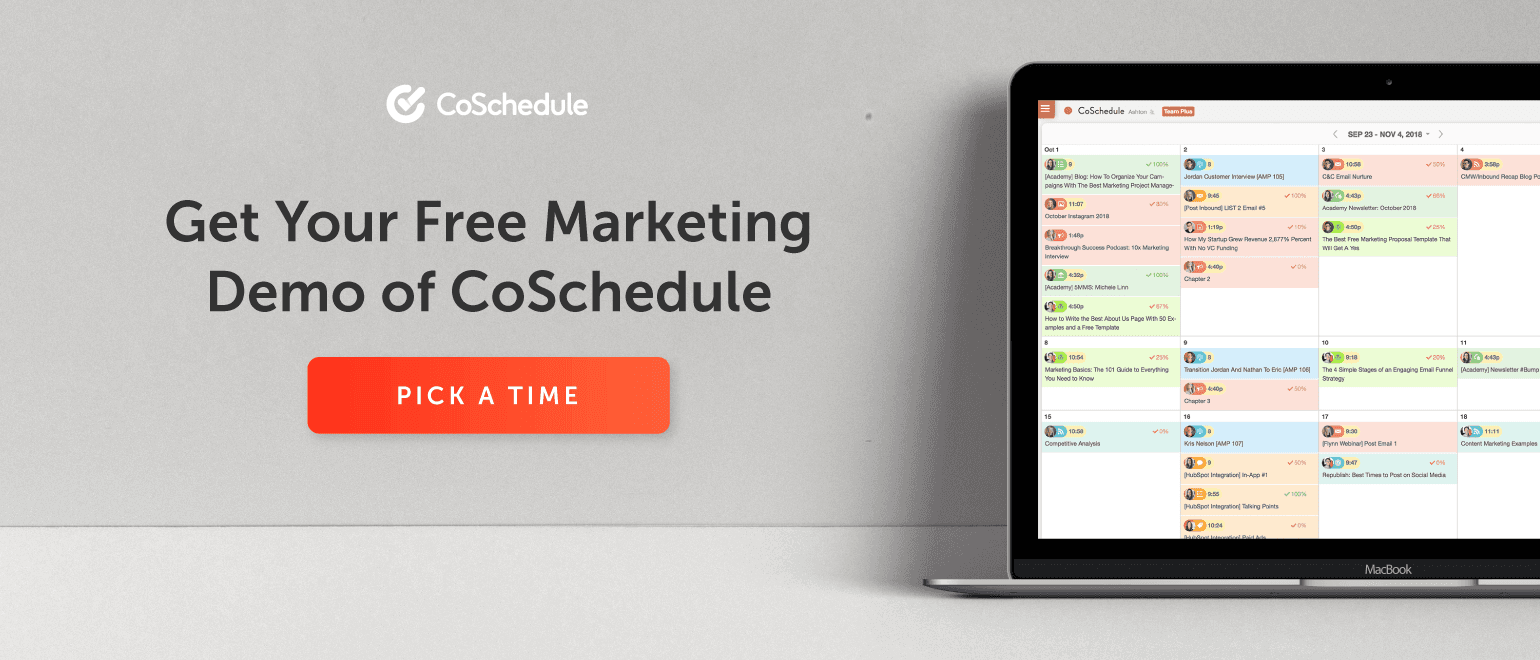 Pick a time, and get completely organized, in control, and look like a BA marketing genius in the process.
I hope you'll take me up on the offer ?
Happy SaaS marketing!
Pick a time, and get completely organized, in control, and look like a BA marketing genius in the process.
I hope you'll take me up on the offer ?
Happy SaaS marketing!